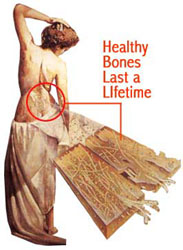Bones

Do All You Can Do To Build Strong Bones
Bone is a Living Tissue
Bone is a hard substance that forms the framework around which the body is built. This framework, or skeleton, contains over 200 separate bones that support and give shape to the body and protect its vital organs. Contrary to a common misconception, bone is a living substance! In fact, bone is one of the most active tissues in the body. It is constantly being broken down and being rebuilt in a process remodeling and, like any other living tissue, needs nourishment to stay strong and healthy.
How Bone is Formed
To begin the process of bone formation, bone cells use proteins and other building blocks to produce a substance know as collagen. Collagen fibers develop quickly to form an organic mesh, or net, that calcium, phosphorus, and numerous other minerals attach to. Over a period of days and weeks (and through a crystallization processinvolving substitution and addition of various minerals) the mixture of different minerals attatching to this organic net changes, producing the finished product called hydroxyapatite crystals. These hydorxyapatite crystals are what makes bone so hard. It is easy to appreciate that bone (pictured in the illustration on the reverse side of this sheet) is much more than just calcium. Other cells facilitate the nourishment of bone by participating in the exchange of nutrients between the bone and the blood. Still other bone cells help to shape, or remodel, the bone by digesting any extra unneeded pieces.
Why Strong Bones Depend on Proper Nourishment
There are three ways that strong bones are dependent on proper nourishment:
- To keep the bone cells healthy and active.
- To supply the variety of important nutritional building blocks needed to form the organic matrix of bone.
- To supply the complex of minerals that need to be placed on that organic net making up the finished, hardened component of bone know as hydroxyapatite crystals. With proper nourishment, a healthy life style, and favorable genetics, healthy bones can last a lifetime!
| Types of Calcium Supplements: Their Advantages and Disadvantages | ||
|---|---|---|
| Types | Advantages | Disadvantages |
| Microcrystalline Hydroxyapatite Concentrate 25% Calcium |
1.Well Absorbed calcium source. 2.Comprehensive bone nourishment. Provides organic constituents and mineral components. |
None |
| Calcium Citrate 24% calcium |
1. Well absorbed 2.Reduces risk of kidney stones 3.Absorbed by those with poor digestion |
Not a complete bone food. |
| Calcium Aspartate 20% | Well Absorbed | Not a complete bone food. |
| Calcium Amino Acid Chelate 10-20% calcium |
Well Absorbed | 1. Not a complete bone food. 2. Often incorrectly made as a soy blend. |
| Calcium Ascorbate 10% |
1. Well Absorbed 2. Non-acidic vitamin C source.f |
Not a complete bone food. |
| Calcium Lactate 15% |
Well Absorbed | 1. Not a complete bone food. 2.May contain milk and/or yeast by-products. 3. Made from fermentation of molasses, whey, starch, or sugar with calcium carbonate. |
| Calcium Carbonate 40% | Cheapest source of calcium | 1. Not a complete bone food. 2. May be malabsorbed by those with poor digestion. 3. Antacid effect, may interfere with digestion, cause gas. |
| Bone Meal 39% |
Contains multiple minerals needed for bone. | 1. May contain high lead, arsenic, cadmium, etc. 2. Organic constituents substantially destroyed by heating processing. |
Microcrystalline Hydroxyapatite Concentrate: Exceptional Bone Nourishment!
Microcrystalline hydroxyapatite concentrate (MCHC) is derived from whole bone and is available as a nutritional supplement. It provides much greater nourishment than just calcium. MCHC contains protein and other ingredients that comprise the organic portion of bone, as well as calcium and other minerals in the normal physiological proportions found in raw bone.
There is no doubt that calcium is essential for healthy bone formation; however, trace minerals and organic factors are also important. Because bone is a complex, highly mineralized tissue, a number of trace mineral deficiencies can impair bone formation and remodeling. Trace minerals also act as cofactors for several enzymes involved in the production of the organic portion of bone. Because MCHC is actual bone, it contains these vital components, which are important for a healthy skeleton. It truly is comprehensive bone nourishment.
Good Mineral Absorption With MCHC
As we age, our ability calcium and other minerals may decline. The calcium in MCHC is bioavailable and may be well absorbed.
MCHC'c Benefits
A number of benefits related to MCHC are summarized in the list below:
- A long with regular exercise and a healthy lifestyle, may help reduce the risk of osteoporosis.
- Bioavailable calcium source.
- Contains collagen protein and the intact organic portion of bone.
- Contains minerals other than calcium that are involved in bone formation and skeletal metabolism: phosphorus, fluoride, magnesium, iron, zinc, copper, manganese, etc.
Assuring the Purity of MCHC
All MCHC products are not created equal. There are many synonyms for the word "hydroxyapatite" that are commonly, yet erroneously, equated with "microcrystalline hydroxyapatite concentrate." They lack the full complement of minerals, organic factors, and the microcrystalline structure so important to the effectiveness of true MCHC. Modern laboratory analysis can now be conducted to confirm the presence of authentic MCHC in a nutritional supplement.
What About Insurance
Coverage for Naturopathic services depends on which company and which policy you have insurance through.
The insurance market is changing rapidly so it is difficult to keep track of which companies are covering
Naturopathic services.
Check with your insurance company, give us a call, or click here to contact us for further information.


